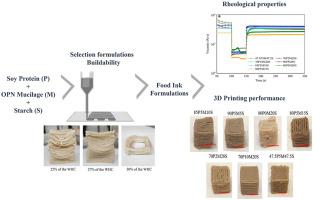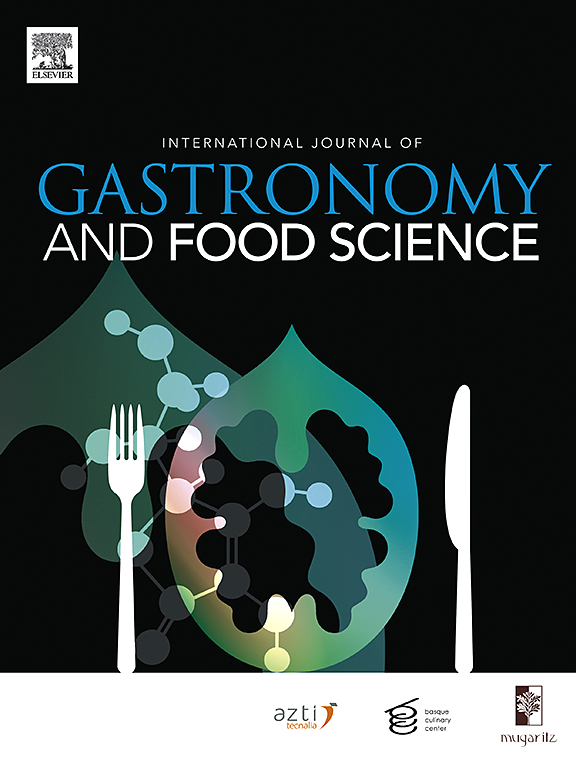Ora-pro-nobis粘液作为3D打印配方的结构成分
IF 3.6
2区 农林科学
Q2 FOOD SCIENCE & TECHNOLOGY
International Journal of Gastronomy and Food Science
Pub Date : 2024-12-01
DOI:10.1016/j.ijgfs.2024.101068
引用次数: 0
摘要
3D食品打印技术允许定制食品纹理,形状和成分,但挑战来自食品矩阵的不同属性。油墨配方必须平衡挤出过程中的流动性和结构稳定性。本研究通过考察Ora-pro-nobis (OPN)胶浆对打印精度和流变行为的影响,研究了其提高3d打印食品结构完整性和打印精度的潜力。食品油墨由不同比例的蛋白质(P)、OPN粘液(M)和淀粉(S)配制而成,总固形物从13.7%到42.7%不等。在测试的配方中,有七种被认为是可印刷的。所有可印刷的油墨都表现出非牛顿的假塑性行为。触变分析表明,黏液在防止印刷后结构坍塌方面起着至关重要的作用。没有黏液(80P0M20S)导致回收率最低(~ 25%),而增加黏液浓度提高了回收率,当其黏液固体含量为10% (70P10M20S)时,回收率达到96%。在印刷精度方面也观察到类似的趋势。将70P10M20S和70P2M28S样品的黏液从10%减少到2%,打印精度从95.5%降低到89.34%,没有黏液的80P0M20S样品的打印精度为73.38%。在配方中加入OPN胶浆可增强油墨弹性、粘度回收率和打印精度,强调其在3D食品打印中的关键作用。本文章由计算机程序翻译,如有差异,请以英文原文为准。

Ora-pro-nobis mucilage as a structuring ingredient in 3D printing formulations
3D food printing technology allows for the customization of food textures, shapes, and compositions, but challenges arise from the diverse properties of food matrices. Ink formulations must balance flowability during extrusion with structural stability. This study investigates the potential of Ora-pro-nobis (OPN) mucilage to enhance the structural integrity and printing precision of 3D-printed food by examining its impact on printing precision and rheological behavior. Food inks were formulated with varying proportions of protein (P), OPN mucilage (M), and starch (S), with total solids ranging from 13.7% to 42.7%. Of the formulations tested, seven were deemed printable. All printable inks exhibited non-Newtonian, pseudoplastic behavior. Thixotropic analysis showed that mucilage was crucial in preventing structural collapse after printing. The absence of mucilage (80P0M20S) resulted in the lowest recovery rate (∼25%), while increasing mucilage concentration improved the recovery rate, reaching 96% with 10% of its mucilage solids (70P10M20S). Similar trends were observed in printing accuracy. Reducing mucilage from 10% to 2% in samples 70P10M20S and 70P2M28S decreased printing accuracy from 95.5% to 89.34%, and 73.38% without mucilage (80P0M20S). Incorporating OPN mucilage in formulations enhanced ink elasticity, viscosity recovery rate, and printing accuracy, underscoring its crucial role in 3D food printing.
求助全文
通过发布文献求助,成功后即可免费获取论文全文。
去求助
来源期刊

International Journal of Gastronomy and Food Science
Social Sciences-Cultural Studies
CiteScore
5.30
自引率
10.50%
发文量
170
审稿时长
45 days
期刊介绍:
International Journal of Gastronomy and Food Science is a peer-reviewed journal that explicitly focuses on the interface of food science and gastronomy. Articles focusing only on food science will not be considered. This journal equally encourages both scientists and chefs to publish original scientific papers, review articles and original culinary works. We seek articles with clear evidence of this interaction. From a scientific perspective, this publication aims to become the home for research from the whole community of food science and gastronomy.
IJGFS explores all aspects related to the growing field of the interaction of gastronomy and food science, in areas such as food chemistry, food technology and culinary techniques, food microbiology, genetics, sensory science, neuroscience, psychology, culinary concepts, culinary trends, and gastronomic experience (all the elements that contribute to the appreciation and enjoyment of the meal. Also relevant is research on science-based educational programs in gastronomy, anthropology, gastronomic history and food sociology. All these areas of knowledge are crucial to gastronomy, as they contribute to a better understanding of this broad term and its practical implications for science and society.
 求助内容:
求助内容: 应助结果提醒方式:
应助结果提醒方式:


